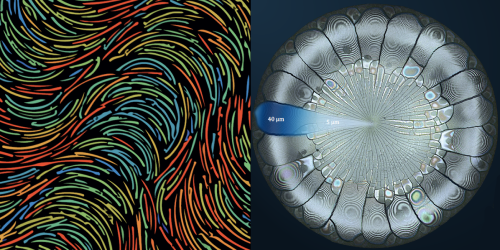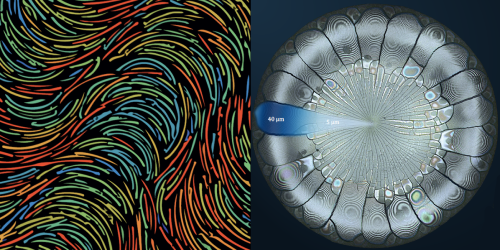Prizes for Breakfast Cereals and Bubble Tears
The APS Division of Soft Matter announced last week the winners of the Gallery of Soft Matter Physics contest at the APS March Meeting in Las Vegas. Here is a rundown of the three videos and two posters that were selected.
Adding Magnets to Breakfast Cereals
Every physicist has at some point asked themself: “What if my breakfast cereal was magnetic?” Well, maybe not every physicist, but certainly Daniel Harris at Brown University, Rhode Island (see Synopsis: The Force that Clumps Your Breakfast Cereal). In trying to understand self-organization processes, he and his colleagues have investigated how magnetic forces affect the “Cheerios effect”—the clustering of particles floating on the surface of a liquid due to attractive capillary forces.
In a study led by postdoc Alireza Hooshanginejad, the team fabricated a set of plastic disks and equipped each with a tiny magnet. When set afloat on a liquid, the disks feel a mutual attraction due to the Cheerios effect, as well as a repulsive magnetic force. Both forces decrease in strength with distance, but the capillary attraction decays faster than the magnetic repulsion. For a certain range of magnetic field strengths, the team found that these forces balance at a certain interdisk spacing, meaning disks can come together up to a point, then settle into a standoff.
The researchers characterized the patterns that form in a system of particles exhibiting such short-range attraction and long-range repulsion. At low particle densities, the system is dominated by repulsion, and the particles assemble into a crystal lattice. As the density increases, particles are forced into closer proximity such that the attractive force begins to dominate; then the particles form clusters and, as the density increases further, stripes.
Seeing How Particles Jam in 2D
Ben McMillan, at the University of Cambridge, UK, and his colleagues also investigated the collective dynamics of plastic disks—in this case, the way disks jam together as they pass through a small hole. The team confined a few hundred transparent polyurethane disks in a 2D vertical hopper with a funnel-shaped opening at the bottom. As the disks slide down the funnel, they occasionally jam together and clog the opening. Because polyurethane’s optical properties change under stress, the researchers were able to visualize the force networks that impede the flow.
They found that clogging occurred when the disks formed an arch that could support the weight of the disks pressing down from above. Some arches were stable, while others were metastable, lasting only so long before collapsing spontaneously. McMillan and his colleagues were able to predict which arches would hold and which would fail by observing fluctuations in the forces between the disks.
Warm Bubbles Live Longer
Creating unusually long-lived bubbles continues to be a goal that captivates physicists (see Synopsis: Record Lifetime for a Bubble). In their study, Saurabh Nath from the Massachusetts Institute of Technology (MIT) and his colleagues extended the lifetime of a bubble not by adding stabilizers, but by exploiting a phenomenon called the Marangoni effect, in which a liquid flows from a region of low surface tension to a region of high surface tension.
The team injected air into silicone oil and watched as bubbles formed and burst. When the oil bath was at 27 °C, the bubbles disappeared almost as soon as they were created. But when the oil was warmed to 68 °C, the bubbles stuck around for longer. Observing the process using an infrared camera, Nath and colleagues found that, in the warmer oil, a pronounced temperature gradient formed between the top and bottom of the bubble. As the surface tension was stronger in the cooler oil at the top, this temperature gradient induced a Marangoni flow upward, which countered the gravity-induced flow that would usually drain the bubble and cause it to pop.
Next, the team arranged the experiment so that the bubble adhered to a metal wire dangling just above the surface of the oil. The upwelling oil formed a liquid meniscus around the wire that grew until it became unstable, at which point some of the oil fell back down into the bath as a “tear drop.” Measuring the size and frequency of tear drops let Nath and colleagues calculate the volume of the Marangoni flow.
Crystals Made of Bananas, and Stress Relaxation in a Drying Droplet
In addition to the three videos, the jury for the contest selected two posters for honors. One poster by Carla Fernández-Rico and Roel Dullens from the University of Oxford, UK, shows the results of a study into the self-organization of colloidal particles having crescent shapes. Resembling Vincent van Gogh’s The Starry Night, the poster illustrates three configurations produced by colloidal “bananas” with different mixes of sizes and curvatures. The other poster, by Mario Ibrahim from MIT and his colleagues, features delicate patterns that look like the wings of a dragonfly but are actually circular deposits from dried-up droplets. The deposits form different crack patterns depending on whether the initial droplet had a large or a small contact angle with the substrate.
–Marric Stephens
Marric Stephens is a Corresponding Editor for Physics Magazine based in Bristol, UK.





